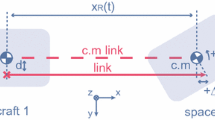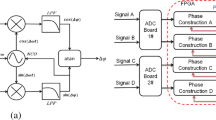Abstract
A strong candidate for use in future missions to map time variations in the Earth's gravity field is laser heterodyne measurements between separate spacecraft. At the shortest wavelengths that can be measured in space, the main accuracy limitation for variations in the potential with latitude is expected to be the frequency stability of the laser. Thus the development of simple and reliable space-qualified lasers with high frequency stability appears to be an important goal for the near future.
In the last few years, quite high stability has been achieved by locking the second harmonic of a Nd:YAG laser to a resonant absorption line of iodine molecules in an absorption cell. Such a laser system can be made quite robust, and temperature related frequency shifts can be controlled at a low value. Recent results from laboratory systems are described. The Allan standard deviation for the beat between two such lasers was 2 × 10−14 at 10 s, and reached 7 × 10−15 at 600 s.
Similar content being viewed by others
References
Bender, P.L.: 1992, ‘Integrated laser Doppler method for measuring planetary gravity fields,’ in From Mars to Greenland: Charting Gravity with Space and Airborne Instruments, IAG Symposium, Vol. 110, Springer-Verlag, pp. 63-72.
Cheng, W.-Y., Chen, L., Yoon, T.-H., Hall, J. L., and Ye, J.: 2002, ‘Sub-Doppler molecular iodine transitions near the dissociation limit (523 to 498 nm),’ Opt. Lett. 827, p. 571.
Colombo, O.L. and Chao, B.F.: 1992, ‘Global gravitational change from space in 2001,’ IAG Symposium Vol. 112, Potsdam.
Danzmann, K.V. et al.: 1998, LISA-Laser Interferometer Space Antenna Pre-Phase A Report, 2nd edn., MPQ 233.
Hammesfahr, A.: 2001 ‘LISA mission study overview,’ Class. & Quantum Grav. 18, pp. 4045-4051.
Ishibashi, C., Ye, J. and Hall, J.L.: 2002, ‘Issues and applications in ultra-sensitive molecular spectroscopy,’ in Methods for Ultrasensitive Detection II, C. W. Wilkerson, Jr., Ed., SPIE Vol. 4634 pp. 58-69.
LISA Study Team: 2000, ‘LISA Laser Interferometer Space Antenna: a Cornerstone Mission for the Observation of Gravitational Waves,’ ESA-SCI(2000)11, European Space Agency.
Robertson, D. I., McNamara, P., Ward, H. and Hough, J.: 1997, ‘Optics for LISA,’ Class. & Quantum Grav. 14, pp. 1575-1577.
Schumaker, B.L.: 1990, ‘Scientific Applications of Frequency-Stabilized Laser Technology in Space,’ Jet Propulsion Laboratory Pub. 90-50, Caltech, Pasadena, CA, pp. 133-146.
Watkins, M.M., Folkner, W.M., Chao, B., and Tapley, B.D.: 2000, ‘EX-5: A laser interferometer follow-on to the GRACE mission,’ presented at GGG2000, Banff, Canada, 31 July–5 August, 2000 (unpublished).
Ye, J., Robertson, L., Picard, S., Ma, L.-S., and Hall, J. L.: 1999, ‘Absolute frequency atlas of molecular I 2 lines at 532 nm,’ IEEE Trans. Instrum. Meas. 48, pp. 544-549.
Ye, J., L.-S. Ma, and J. L. Hall: 2001, ‘Molecular iodine clock,’ Phys. Rev. Lett. 87, pp. 270801/1-4.
Author information
Authors and Affiliations
Rights and permissions
About this article
Cite this article
Bender, P.L., Hall, J.L., Ye, J. et al. Satellite-Satellite Laser Links for Future Gravity Missions. Space Science Reviews 108, 377–384 (2003). https://doi.org/10.1023/A:1026195913558
Issue Date:
DOI: https://doi.org/10.1023/A:1026195913558




